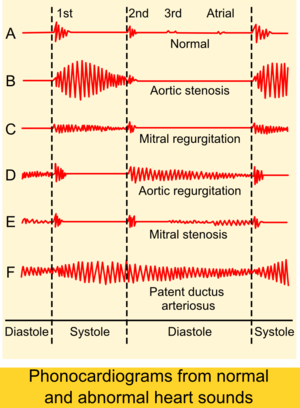Continuous murmurs
Heart murmurs are most frequently organized by timing, into systolic heart murmurs and diastolic heart murmurs. However, continuous murmurs can not be directly placed into either category.[1]

Auscultogram from normal and abnormal heart sounds
These murmurs are due to blood flow from a high pressure chamber or vessel to a lower pressure system.
- Patent ductus arteriosus. PDA is an abnormal connection between the aorta and the pulmonary artery, which normally should be closed in infancy. Since aortic pressure is higher than pulmonary pressure, a continuous murmur occurs. This murmur is often described as a machinery murmur, or Gibson's murmur.[2] This is named for George Alexander Gibson, who characterized it in 1898.[3][4]
- Aortopulmonary window.
- shunts. Usually a left to right shunt through a small atrial septal defect in the presence of mitral valve obstruction.
References
- "continuous murmur" at Dorland's Medical Dictionary
- "Gibson murmur" at Dorland's Medical Dictionary
- Gibson GA 1898 Diseases of the heart and aorta. Pentland, Edinburgh, pp 61, 303, 310–312
- Tynan M (December 2003). "The murmur of the persistently patent arterial duct, or "The Colonel is going to a dance"". Cardiol Young. 13 (6): 559–62. PMID 14982298.
This article is issued from Wikipedia. The text is licensed under Creative Commons - Attribution - Sharealike. Additional terms may apply for the media files.